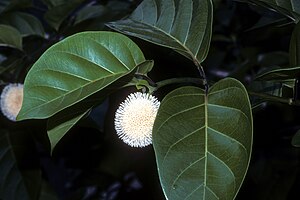Nauclea latifolia
| Nauclea latifolia | ||||||||||||
|---|---|---|---|---|---|---|---|---|---|---|---|---|

Leaves and inflorescence of Nauclea latifolia |
||||||||||||
| Systematics | ||||||||||||
|
||||||||||||
| Scientific name | ||||||||||||
| Nauclea latifolia | ||||||||||||
| Sm. |
Nauclea latifolia is a tree or shrub in the red family from West and Central to East Africa .
description
Nauclea latifolia grows as a mostly evergreen , small tree or shrub up to 6–12 meters high. The bark is cracked and brownish.
The simple, almost bare and slightly leathery, dark green leaves are opposite. They are round to ovate, lanceolate or elliptical, oblong to obovate. The petiole is often reddish to purple and up to 2 inches long. The leaf margin is whole and the tip is pointed to pointed. The slightly raised veins on the underside are pinnate and lighter to the base reddish to purple. There are some tough, small, reddish and egg-shaped, lace, interpetiolare Stipules present. The stipules are also, as well as reddish and reduced leaves under the inflorescence. Domatia may be present on the secondary veins of the nerve .
The spherical, stalked and many-flowered inflorescence is terminal and about 4–5 centimeters in size. The inflorescence stalk is up to 2–2.5 inches long. The whitish to yellowish and orange and trumpet-shaped, hermaphrodite and pleasantly scented flowers are five-fold with a double flower envelope . The small flowers are interconnected at the calyx and ovary grown. The small, hairy calyx is fused with 5 small and unequal tips and with 5 sloping and club-shaped, slightly hairy appendages. The corolla tube is first long and narrow, then funnel-shaped with roof-tiled and rounded lobes. The 5 short stamens , with short stamens, sit inside the funnel at the throat of the crown. The two-chamber ovary is subordinate. The white to yellowish stylus is long and far above, with a white, cone to spindle-shaped scar .
The spherical, fleshy and red fruit associations are about 5–8 centimeters in size. The shell is pitted, bumpy with pentagonal depressions. The many round, reticulate-pitted seeds are about 1 millimeter in size.
distribution
Nauclea latifolia occurs from tropical West Africa to Ethiopia and northwestern Angola.
Systematics
It was first described as Nauclea latifolia in 1813 (1819) by James Edward Smith in A. Rees, The Cyclopædia.… 24: (under NAU). Synonyms are Cephalina esculenta (Afzel. Ex Sabine) Schumach. & Thonn. , Nauclea esculenta (Afzel. Ex Sabine) Merr. , Nauclea sambucina T. Winterb. , Sarcocephalus esculentus Afzel. ex Sabine , Sarcocephalus russeggeri Kotschy ex Schweinf. , Sarcocephalus latifolius (Sm.) EABruce and Sarcocephalus sambucinus K.Schum.
use
The fruits are eaten raw and the flower heads are cooked as vegetables.
literature
- D. Bridson, B. Verdcourt: Flora of Tropical East Africa. Rubiaceae, Part 2, CRC Press, 1988, ISBN 90-6191-337-3 , p. 439 ff.
Web links
- Nauclea latifolia at Useful Tropical Plants.
- Nauclea latifolia . In: U. Brunken, M. Schmidt, S. Dressler, T. Janssen, A. Thiombiano, G. Zizka: West African plants - A Photo Guide. Senckenberg Research Institute, Frankfurt am Main 2008.
Individual evidence
- ↑ a b Rafaël Govaerts (Ed.): Nauclea latifolia. In: World Checklist of Selected Plant Families (WCSP) - The Board of Trustees of the Royal Botanic Gardens, Kew . Retrieved June 2, 2020.
- ↑ online at biodiversitylibrary.org.
